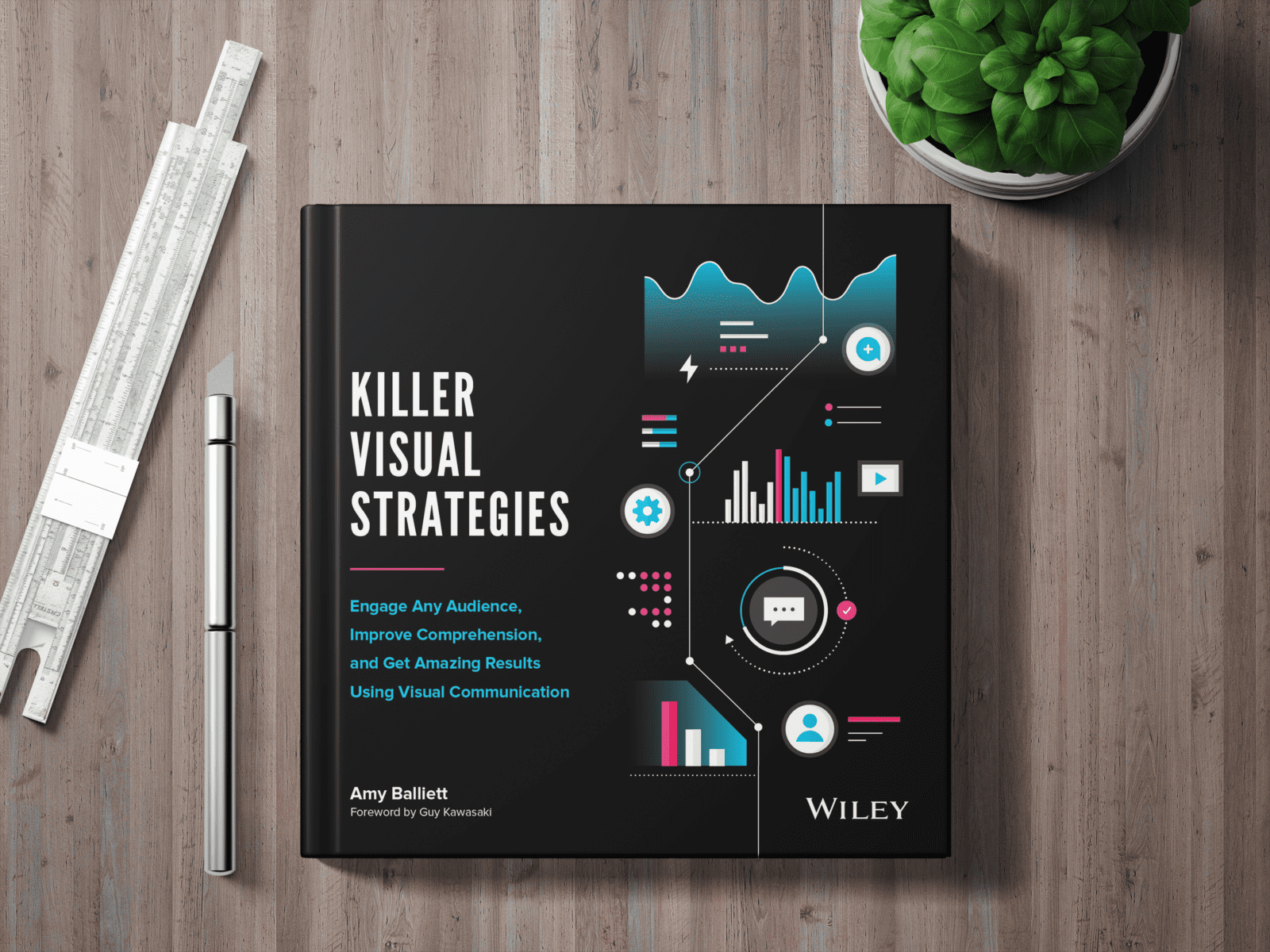8 Rules for a Killer Visual Strategy

By Payal Parikh, Director of Client Engagement at Heinz Marketing
Have you redefined your visual strategy post pandemic? Now that most of us are working from home, we need even better communication tools and strategies to help us get our message across to both colleagues and clients. The importance of visual communication is emphasized even in the pre-COVID era, and with the current new normal, it has become extremely important to get your message across efficiently and effectively.
I recently came across Amy Balliett’s book ‘Killer Visual Strategies‘ and would like to share my thoughts about this action packed insightful book so you can connect and engage with your audience efficiently and effectively. Amy claims she is not a graphic designer, she’s a visual strategist. The contents of the book hold true to that. The book is not about graphic designing or how visually appealing your content should be, but it is about using the right visual strategies to convey the message to your target audience.
The book begins with an overview of the environmental factors that have contributed to our present-day consumer demand for visual content by summarizing key moments in recent history that have shifted audience expectations.
Amy has outlined 8 Rules of visual communications in the first part of the book followed by a thorough explanation of why the rule exists. The book provides concise steps you can apply to your visual content immediately! The rules refer to the subconscious effects different design choices have on those viewing the content.
8 Rules of Visual Communications
Rule 1: Always think about Con-Text (It’s a CON when there’s too much text)
Your infographic or visuals should not be a reading assignment. Text can be used to provide some context, but it shouldn’t be too much. To test this, design your visual content using lorem ipsum text where your copy will go. This will force you to tell your story with visuals rather than words. I think it’s a brilliant suggestion!
Rule 2: Small visual cues have a large impact
Amy cites an example on Twitter’s star vs heart debacle of 2015 and shows how seemingly small visual cues can make a huge impact on the actions of any audience.
Great visual communication leans into the fact we read similar meaning into popular iconography. Embrace this fact and consider the ways in which small visual cues can best speak to your audience.
Pro Tip: TheNounProject.com offers the most diverse collection of icons you can use as an inspiration for your own content.
Rule 3: Choose your colors wisely (strategically)!
90% of product purchase decisions are based on color
Our eyes seek out patterns in color to help us make sense of the information we are consuming. By applying colors strategically – for instance, always using the same color as a ‘fill’ shade in data visualizations – you can help your viewers comprehend the content far more efficiently. Likewise, by choosing colors that align with your topic, you can ensure that your audience will embrace that content with ease. And when your color choices don’t complement the topic, the best way to avoid confusion is to keep your palette limited and clean.
Rule 4: WTF – Why this font?
In this chapter (rule), Amy has encapsulated some of the most popular fonts and their characteristics. Fonts are an artistic representation of letters and numbers. They deliver a visual aesthetic long before their individual characters combine to create words. Because of this, all visual strategists must consider font choices as part of their core communication strategy.
Rule 5: Avoid the stigma of stock
Today’s audiences crave originality above all else. For this rule, I understand for smaller organizations budget is a constraint. I would say, follow this rule whenever possible.
Rule 6: Define your target audience and speak only to your audience
The Ideal Customer Profile is the prefect customer for what your organization solves for, kinda like a best fit. Amy gives a perfect example of a cocktail party. Think about a networking event where you won’t be talking to each and every person who is present. You know your goals and you know who fits your criteria. The idea is to talk only to your target audience to be more effective.
Read our ‘How to create an Ideal Customer Profile’ blog post to understand how to define your target audience.
Rule 7: Use proper data visualization throughout
Amy offers some exercises to help you identify problems with different data visualization charts. Try them for yourself! Although common sense, I can see how anyone of us can get carried away and make mistakes as silly as some shown in the examples.
Here’s a truth check. If you answer yes to even a single question below then you need to rethink your data viz strategy:
- Will your audience have to work to understand your chart?
- Are there chances of misinterpretation?
- Is it building trust in your brand?
As a test, before presenting to external/internal audiences, ask a colleague to read your chart and see if the interpretation is what you would expect from your audience.
Rule 8: Commit to the truth and prove it
In this era of fake news, our audience is pretty skeptical on what’s real and what’s fake. It is important to earn audience trust by committing to the truth in all the visual content you produce and by being transparent in citing all the primary sources that informed said content.
You must be thinking, there are a lot of rules to follow! Keep in mind, these rules lay a solid foundation to your visual strategy. Amy Balliett reveals which of these rules are ‘okay’ to be broken in the second part of the book.
Rules are meant to be broken!
This is a very intelligently woven section which exemplifies what happens when you break each rule highlighted in the previous section.
The rules of visual communication exist to provide guidance on developing successful visual content. But they do not have to be taken so seriously that you never bend or break them. When determining which rules matter most, you should always consider the goals of your content, your target audience and the information you are trying to share. Sometimes you’ll find adhering too strictly to a rule will have adverse effects on your goals, can alienate your audience and can also misrepresent your information. If this is the case, use the rule as a guidepost only.
It is OK to bend or break a rule if it is helping you better represent the information or achieve your goals with more efficiency. However, there are a few rules you should always follow. Read the book to find out which ones.
Conclusion: We are naturally inclined to communicate visually. Embracing this element of human nature is imperative to creating a great visual strategy. The broader one’s understanding of the human experience, the better design we will have.
Amy provides scientific evidence visuals communicate information faster than words. Not only do we communicate visually, but we think visually as well. In fact, research shows by leading with visuals, you have the opportunity to connect and engage with your audience far more efficiently.
For brands to survive and, ultimately, thrive, they must develop and prioritize visual strategies. And there are 3 elements for a successful visual strategy:
- Message
- Channel
- Audience
Follow a process while creating your visual content and see the higher quality results you get from your audience.
About the Author
Amy Balliett is the CEO and co-founder of Killer Visual Strategies, an industry-leading visual communication agency that designs and executes communication and content marketing solutions for Fortune 1000 clients. Amy is also the host of The Strategic Content Summit – a weekly webinar series featuring some of the world’s most innovative marketers, design leaders, futurists, and visual communication strategists — all gathered to answer one question: what does the strategic content of the future look like, and how can brands make the leap to get there?
Join Matt Heinz, President and co-founder of Heinz Marketing and one of the world’s Top 50 Keynote Speakers, in conversation with Amy Balliett about how marketers and sales departments can develop a content strategy that drives steady growth for their organizations. Register here to join Matt’s session on September 1, 2020.

